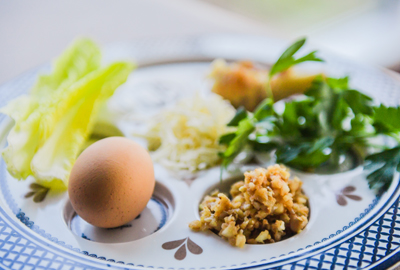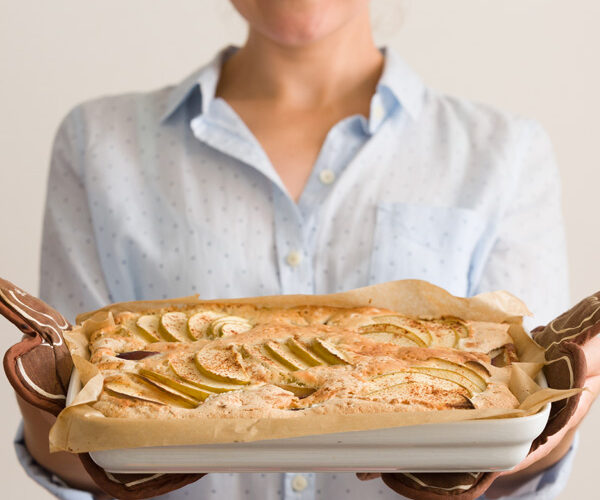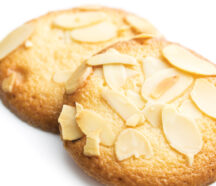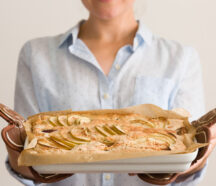By Gabrielle Burger, Director, Jewish Educational Engagement, Macks CJE
My Story: The Sephardic and Ashkenazi Seder Table

For the Jewish people, Passover is a holiday of many traditions. Some of these traditions are around food, around song tunes, and even around hide and seek!
Family traditions and customs are something of much debate in my home because I come from a Sephardic home, and my husband comes from an Ashkenazi home. How do you take family traditions and customs that have been passed down from generation to generation with such different flavors and make them into something new? Can it be done? I tell you it can, and in my mind makes our Passover Seder that much richer and more exciting.
I have had the pleasure of attending many Sephardic and Ashkenazi seders in my life. Living many of my teenage years in Memphis, TN meant almost all those Passovers were Ashkenazi. We were one of the very few Sephardic families in town, and the only Syrian family for sure.
What was most surprising to me was how comfortable I was no matter what flavor of seder I attended. Were there differences? Yes of course. Many. But the feeling and spirit of this holy event was there no matter what.
Where I found the most differences were in the foods that were served, how they were prepared, and what people did with it.
Let’s start with food!
Traditionally for Ashkenazi families, there are certain foods called legumes/kitnyot in Hebrew (peas, corn, beans, rice, etc.) that are not eaten during Passover, whereas Sephardic families have the custom of eating them. This is a big difference, since this custom of eating/not eating kitnyot makes it difficult to eat at other homes depending on your custom.
It also means that the foods that are prepared will be very different. My Sephardic family makes stuffed cabbage every Passover, but we make it including rice. My husband’s Ashkenazi family would never eat this with rice.
One of the more debated foods in our home is the charoset. This is a very traditional Passover food on every table, since it is part of the actual seder plate and is used during the recitation of the Passover story.
Charoset is meant to symbolize the mortar used between the stones while building the pyramids. My family recipe uses dates as the base, which makes a very sticky, dark brown spread meant to really look like mortar. My husband’s family uses apples instead as the base. As a compromise, I make the charoset using my recipe, and we serve gefilte fish with mayonnaise and horseradish with the meal, which was not a food I grew up eating.
Now let’s talk about hide and seek.
The afikomen is a very important piece of matzah that is hidden at some point during the meal. This is where I have found that tradition has nothing to do with Sephardic or Ashkenazi upbringing.
Some families hide the afikomen around the table, where others around the home. Either way, the children (or the youngest at the meal) are tasked with finding it for the meal to end. Traditionally, the meal cannot end without eating pieces of the afikomen, which means the meal cannot end until the afikomen is found.
In some homes the finder barters for a gift in exchange for the return of the afikomen. In our home, the person who finds the afikomen holds it hostage, and possibly re-hides it until the gift is secured!
There are so many other ways in which families make the Passover seder their own. Some have special storytelling techniques to keep the kids invested, others have special tunes for the songs that have been perfected over the years.
A powerful Persian storytelling custom is to hit each other with scallions while singing the song Dayenu as the taskmasters of Egypt whipped the Israelites during slavery.
Some families have special tunes for the songs that have been perfected over the years. Other families (including my own) use marshmallows as motivation for asking questions or sharing pieces of Torah/interesting tidbits of knowledge. No matter where your family originated, Passover is a time to come together, teach our children, share our customs and hope for the future.

Try this Sephardi Recipe for Charoset from My Jewish Learning
- 1 cup dried figs
- 1 cup raisins
- 1 cup pitted Medjool dates
- 1 cup almonds
- 1/2 teaspoon cinnamon
- 1/2 teaspoon cardamom
- 1/2 teaspoon ginger
- 1/2 teaspoon allspice
- 2-3 tablespoons pomegranate juice
1. Put the figs, raisins, dates and almonds into a food processor. Pulse until paste is thick and sticky.
2. Transfer contents to a large bowl.
3. In a small bowl, mix the pomegranate juice and spices together and pour over fruit-nut mixture. Mix. If the mixture is too dry, add more pomegranate juice.
4. Pinch off a piece of mixture and roll into a ball. Keep a bowl of tepid water on hand, as your hands will get covered.
Jay Rosen on myjewishlearning.com. Recipe provided by Macks CJE
Subscribe to our newsletter
The Associated is a home for everyone in the Baltimore Jewish community. We offer several email lists to help people find a community, engage with their peers and support Jewish journeys around the world.
Join Our Mailing ListAdd Impact to Your Inbox
Sign up for our newsletter
Subscribe to our newsletter
The Associated is a home for everyone in the Baltimore Jewish community. We offer several email lists to help people find a community, engage with their peers and support Jewish journeys around the world.
Join Our Mailing List









 Please Wait while we loading your video.
Please Wait while we loading your video.